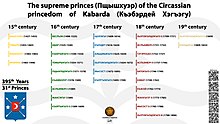
Back Инал ADY Çərkəz İnal Azerbaijani Inal Spanish ინალ დიდი Georgian Инал KBD Inal, o Grande Portuguese Инал (князь) Russian İnal (Çerkesya kralı) Turkish Інал Великий Ukrainian
| Inal the Great Inal the Radiant Inal the Blind | |||||
|---|---|---|---|---|---|
| King of Circassia | |||||
 Circassia during the reign of Inal | |||||
| Reign | 1427 – 1453 | ||||
| Predecessor | Office established | ||||
| Successor | Various princes self-proclaim themselves | ||||
| Grand Prince of Zhaney-Zichia | |||||
| Reign | 1427 – 1453 | ||||
| Predecessor | Parsabok (Berzebuch)[1] | ||||
| Successor | Temruk (?) | ||||
| Grand Prince of Chemguy-Hatuqway | |||||
| Reign | 1427 – 1453 | ||||
| Predecessor | Office established | ||||
| Successor | Temruk[2] | ||||
| Grand Prince of Kabardia | |||||
| Reign | 1434 – 1453 | ||||
| Predecessor | Office established | ||||
| Successor | Tabulda[3][4] | ||||
| Grand Prince of Besleney | |||||
| Reign | 1434 – 1453 | ||||
| Predecessor | Office established | ||||
| Successor | Beslan[2] | ||||
| Born | Taman, Zichia | ||||
| Died | 1458 Grand Principality of Circassia | ||||
| Burial | |||||
| Spouse | Two wives, an unnamed Abkhaz Anchabadze princess & an unnamed Circassian noblewoman | ||||
| Issue | Тэбылду (Tabulda) Темырикъу (Temruk) Жанхъуэт (Jankhot) Минболэт (Minbolat) Беслъэн (Beslan) Унэрмэс (Wunarmas) Къэрмыщэ (Qermisha) | ||||
| |||||
| Dynasty | Inalid | ||||
| Father | ХъурыфэлӀ (Xhurıfəl') | ||||
| Religion | Eastern Orthodox Christianity syncretised with Khabzeism | ||||
Inal Nekhu (Adyghe: Инал Нэф, romanized: Yinal Nəf, lit. 'Inal the Radiant'; Kabardian: Инал Нэху, romanized: Yinal Nəxw, lit. 'Inal the Radiant'; also known as Inal the Great in Georgian sources) was the Supreme Prince (King) of Circassia from 1427 to 1453 who unified all Circassians (then divided into several princedoms) into one state.[5][6] He led campaigns into several countries and expanded borders on all directions.[7] He was the founder of several Circassian tribes, mainly Kabardia, Besleney, Temirgoy, Zhaney, and Hatuqwai.
Although the origin of Inal's nickname (Nef/Nekhu) is not known, sources claim that he had one eye blind, therefore it came from the word "Нэф" meaning "blind" in Circassian, and some claim that it came from the word "Нэху" meaning "enlightened" in Circassian.[8]

- ^ Khatko, Samir. Черкесские княжества в XIV - XV веках: вопросы формирования и взаимосвязи с субэтническими группами
- ^ a b Родословная карта № IV «Б»
- ^ "Родословная кабардинских князей и мурз XVII в. (из родословной книги, принадлежавшей А. М. Пушкину)". Archived from the original on 2016-02-07. Retrieved 2019-03-23.
- ^ "Родословная кабардинских князей и мурз XVII в. (из родословной книги, принадлежавшей А. И. Лобанову-Ростовскому)". Archived from the original on 2014-04-13. Retrieved 2019-03-23.
- ^ "PRENSLERİN PRENSİ İNAL NEKHU (PŞILERİN PŞISI İNAL NEKHU)". cherkessia.net (in Turkish). Retrieved 2021-03-29.
- ^ Абасова, Шамсият (26 December 2020). Взгляд на османские и кавказские дела. Litres. ISBN 9785042257544. Archived from the original on 7 July 2020.
- ^ "PRENSLERİN PRENSİ İNAL NEKHU (PŞILERİN PŞISI İNAL NEKHU)". KAĞAZEJ Jıraslen. 2013. Archived from the original on 29 February 2020.
- ^ "Prince Inal the Great (I): The Tomb of the Mighty Potentate Is Located in Circassia, Not Abkhazia". Amjad Jaimoukha. Circassian Voices. 2013. Archived from the original on 4 June 2020.